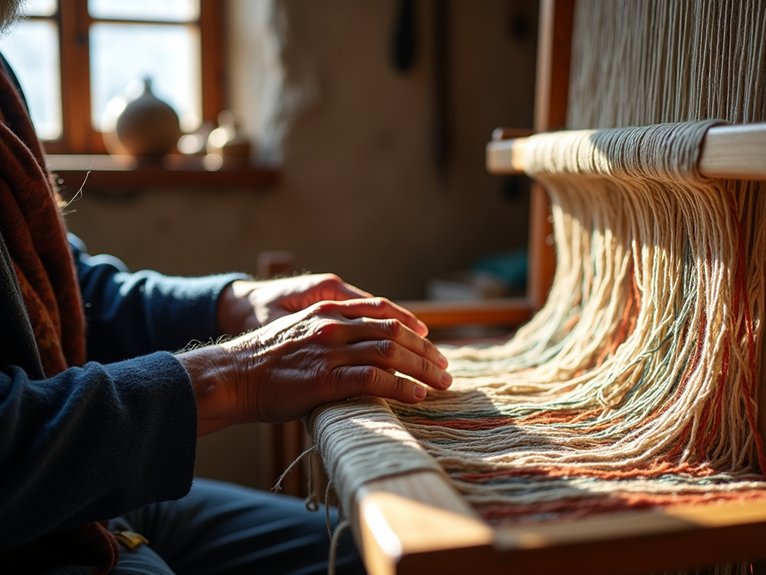Learning traditional weaving begins with understanding its cultural significance and history. Beginners need basic tools including a loom, shuttles, heddles, and natural fibers like cotton or wool. Start by properly warping the loom and practicing fundamental techniques such as tabby, twill, and basket weave. Create simple projects like table runners to develop skills. Consistent practice helps master tension and pattern work. Traditional weaving connects practitioners to ancient craft traditions passed down through generations.
Understanding the History and Cultural Significance of Traditional Weaving

The art of weaving stands as one of humanity’s oldest and most widespread crafts, dating back at least 27,000 years according to archaeological evidence. This ancient technique has evolved across civilizations, from Egyptian linen production to Navajo blankets and Peruvian textiles.
Traditional weaving reflects cultural identity through distinctive patterns, materials, and techniques passed down generations. These textiles often communicate social status, tribal affiliation, and spiritual beliefs through symbols and designs.
Understanding weaving’s historical context enhances appreciation for this craft beyond technical skill, connecting practitioners to a global heritage of human creativity and cultural expression that continues to inspire modern fiber artists.
Essential Tools and Materials for the Traditional Weaver
With a foundation in weaving’s rich history established, aspiring weavers must first assemble appropriate equipment before practicing this ancient craft. Traditional weaving requires several essential tools: a loom (rigid heddle, floor, or table varieties), shuttles for carrying weft threads, heddles to separate warp threads, and a beater to compact woven rows.
Materials include natural fibers such as cotton, wool, linen, and silk. Quality yarn with consistent thickness guarantees even weaving. Beginners should start with medium-weight cotton yarn. Additional supplies include scissors, measuring tape, tapestry needles, and a notebook to record patterns and techniques.
Setting Up Your First Loom

Setting up a loom correctly establishes the foundation for successful weaving projects. Begin by inspecting all loom parts to guarantee proper functioning and stability. Secure the frame on a flat surface before attaching the heddles and reed according to the manufacturer’s specifications.
Next, measure and prepare the warp threads, allowing extra length for loom waste. Thread the warp through heddles in the prescribed pattern, maintaining even tension throughout. Secure warp ends to the back beam, then wind carefully while keeping threads parallel.
Finally, tie the warp to the front beam and adjust tension until it feels uniform when plucked.
Learning Basic Weaving Techniques and Terminology
Mastering basic weaving terminology creates a solid foundation for developing practical skills. Weavers should first understand essential terms: warp (vertical threads), weft (horizontal threads), shed (space between separated warp threads), and selvedge (finished edge of fabric).
Fundamental techniques include tabby (plain weave), twill (diagonal pattern), and basket weave. Beginners practice warping the loom properly, creating consistent tension, and maintaining even selvedges. Learning proper shuttle handling enhances smooth weft insertion.
To develop rhythm and muscle memory, new weavers should practice short, focused sessions before attempting complex patterns. This methodical approach builds confidence while preventing discouragement and technical errors.
Exploring Different Traditional Weaving Patterns

Traditional weaving patterns offer a gateway to cultural heritage while providing weavers with structured designs to enhance their technical abilities. Common patterns include plain weave (tabby), twill, herringbone, and diamond formations.
Plain weave creates a simple over-under structure, ideal for beginners. Twill patterns feature diagonal lines created by passing weft threads over multiple warps. Herringbone showcases a zigzag effect through alternating twill directions.
Cultural patterns vary considerably: Navajo rugs employ geometric designs, Scottish tartans use distinctive color arrangements, and Peruvian textiles incorporate symbolic motifs. Each tradition uses specific techniques that reflect regional history and available materials.
Mastering Warp and Weft: The Foundation of Weaving
The foundation of all weaving projects lies in understanding the relationship between warp and weft threads. Warp threads run vertically on the loom, creating tension and structure.
Weft threads weave horizontally through the warp, forming the fabric’s pattern and integrity.
Proper warping requires careful measuring, even spacing, and consistent tension. Too tight, and the fabric puckers; too loose, and it becomes unstable.
The weaver’s shuttle carries weft threads over and under the warp in rhythmic patterns, building the textile row by row.
Mastering this fundamental interaction enables weavers to create everything from simple tabby weaves to complex tapestries.
Finding and Learning From Master Weavers
While understanding warp and weft creates a foundation for weaving, apprenticeship with experienced practitioners accelerates skill development substantially. Aspiring weavers benefit from seeking established artisans through guilds, cultural centers, and textile workshops.
Master weavers provide invaluable guidance on technique refinement, pattern interpretation, and troubleshooting common mistakes. Many offer structured workshops or one-on-one mentoring sessions where students observe proper posture, tension control, and efficient movements.
The mentor-apprentice relationship extends beyond technical instruction to include cultural knowledge, historical context, and sustainable practices. This traditional learning approach preserves textile heritage while fostering community among practitioners dedicated to maintaining this ancient craft.
Regional Weaving Styles and Their Unique Characteristics
Across the globe, weaving techniques vary dramatically based on geography, available materials, and cultural heritage, resulting in distinct regional styles that reflect centuries of artistic evolution.
Native American Navajo weaving features geometric patterns and natural dyes, while Scandinavian traditions emphasize symmetrical designs and vibrant colors. Southeast Asian ikat involves precise tie-dyeing of threads before weaving, creating distinctive blurred patterns.
West African kente cloth combines intricate geometric motifs with symbolic meanings, while Peruvian textiles often incorporate complex figures and narrative elements. Each regional tradition offers unique learning opportunities, from Scottish tartan’s mathematical precision to Japanese kasuri’s delicate resist-dye techniques.
Natural Dyes and Fiber Preparation
Before modern synthetic alternatives dominated the textile industry, natural dyes and careful fiber preparation formed the foundation of all weaving traditions worldwide. Plant-based dyes like indigo, madder root, and weld created blues, reds, and yellows, while minerals and insects provided additional hues.
Fiber preparation begins with harvesting wool, cotton, flax, or silk, followed by cleaning to remove debris and natural oils. Next comes carding or combing to align fibers, and spinning to create yarn of consistent thickness. Many traditional weavers maintain these practices to preserve authenticity and sustainability, using locally sourced materials that connect their work to both land and history.
Common Challenges and Troubleshooting for Beginners
Most beginning weavers encounter a predictable set of challenges that can cause frustration but are easily resolved with proper guidance. Common issues include uneven tension resulting in wavy edges, incorrect threading causing pattern errors, and broken warp threads disrupting the weaving process.
To troubleshoot these problems, beginners should regularly check tension, maintain consistent beating pressure, and use a threading draft to verify proper setup. When threads break, they can be repaired by tying new threads with weaver’s knots. Keeping detailed notes of each project helps identify recurring issues and solutions for future reference.
Creating Your First Traditional Weaving Project
Now that troubleshooting techniques have been addressed, beginner weavers can confidently approach their first traditional project. A simple table runner offers an ideal starting point, requiring basic plain weave structure while developing fundamental skills.
Weavers should select smooth, medium-weight cotton yarn in contrasting colors for visual interest. The project requires warping approximately 30 cm wide with 4 ends per cm (ends per inch) and measuring about 91 cm in length plus 51 cm for loom waste and fringe.
Begin by creating a balanced weave, maintaining consistent tension throughout. Complete the project by securing the edges with hemstitching and adding twisted fringe for a traditional finish.
Preserving and Sharing Traditional Weaving Knowledge
Preserving and Sharing Traditional Weaving Knowledge
The preservation of traditional weaving knowledge represents a pivotal aspect of cultural heritage conservation worldwide. Communities maintain these practices through oral traditions, apprenticeships, and documentation.
Experienced weavers can contribute by teaching workshops, recording techniques, or collaborating with cultural institutions to archive patterns and methods.
Digital platforms offer contemporary avenues for preservation—online tutorials, video demonstrations, and virtual communities connect practitioners across regions. Cultural centers and museums play essential roles by organizing exhibitions, hosting master classes, and creating permanent collections of significant works.
Each person who learns traditional weaving becomes a vital link in maintaining these ancestral crafts for future generations.



